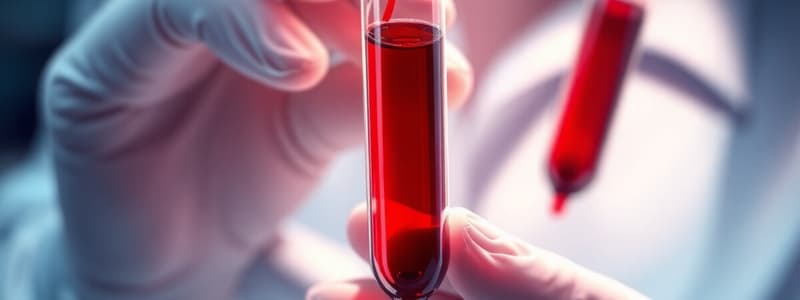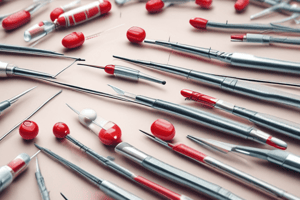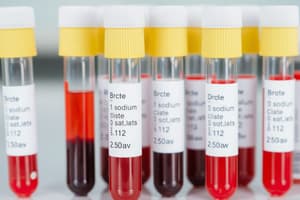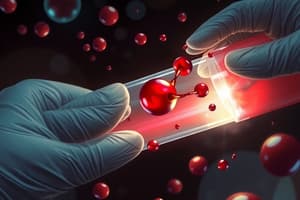Podcast
Questions and Answers
Which type of blood collection tube is used to obtain serum by separating it from blood via centrifugation and coagulation?
Which type of blood collection tube is used to obtain serum by separating it from blood via centrifugation and coagulation?
- Gray top tube
- Red top tube (correct)
- Lavender top tube
- Green top tube
Which of the following blood collection tubes contains lithium heparin and is primarily used to collect plasma for biochemical tests?
Which of the following blood collection tubes contains lithium heparin and is primarily used to collect plasma for biochemical tests?
- Yellow top tube
- Blue top tube
- Green top tube (correct)
- Red top tube
Which blood collection tube contains K2 or K3 EDTA and is used in hematology for complete blood counts (CBC)?
Which blood collection tube contains K2 or K3 EDTA and is used in hematology for complete blood counts (CBC)?
- Red top tube
- Blue top tube
- Lavender top tube (correct)
- Green top tube
What is the primary use of blood collection tubes containing sodium citrate?
What is the primary use of blood collection tubes containing sodium citrate?
Which of the following assays typically requires a blood collection tube that is specially manufactured not to contain trace metals?
Which of the following assays typically requires a blood collection tube that is specially manufactured not to contain trace metals?
Which of the following blood collection tubes maintains glucose stability for up to 5 days due to the presence of antiglycolytic agents?
Which of the following blood collection tubes maintains glucose stability for up to 5 days due to the presence of antiglycolytic agents?
Which blood collection tube is used for immediate coagulation of blood samples, especially when there is an urgent need for serum in biochemical analysis?
Which blood collection tube is used for immediate coagulation of blood samples, especially when there is an urgent need for serum in biochemical analysis?
Which of the following blood collection tubes is most suitable for hormone, microbiology, and biochemistry analyses?
Which of the following blood collection tubes is most suitable for hormone, microbiology, and biochemistry analyses?
What is the significance of inverting a blood collection tube containing EDTA (like a lavender top tube) immediately after collection?
What is the significance of inverting a blood collection tube containing EDTA (like a lavender top tube) immediately after collection?
For which type of laboratory analysis would it be most important to avoid any additives in the blood collection tube that could introduce metallic contaminants?
For which type of laboratory analysis would it be most important to avoid any additives in the blood collection tube that could introduce metallic contaminants?
If a phlebotomist needs to collect blood for both a CBC and coagulation tests, which tubes should be drawn, and in what order, according to CLSI guidelines?
If a phlebotomist needs to collect blood for both a CBC and coagulation tests, which tubes should be drawn, and in what order, according to CLSI guidelines?
When should a phlebotomist be particularly mindful of the fill volume when using a grey top tube?
When should a phlebotomist be particularly mindful of the fill volume when using a grey top tube?
A doctor orders a test that requires serum but time is of the essence. Which tube should a phlebotomist use?
A doctor orders a test that requires serum but time is of the essence. Which tube should a phlebotomist use?
Which of these tests would yellow top tubes be inappropriate for?
Which of these tests would yellow top tubes be inappropriate for?
Which tube is most appropriate for cross match analysis?
Which tube is most appropriate for cross match analysis?
What specific additive found in green top tubes enables the separation of plasma, and what is the mechanism of action?
What specific additive found in green top tubes enables the separation of plasma, and what is the mechanism of action?
In which scenario would the use of serum separated from a red top tube sample be MOST appropriate?
In which scenario would the use of serum separated from a red top tube sample be MOST appropriate?
What is a possible patient-related consequence of not filling to the indicated volume when using an open gray tube?
What is a possible patient-related consequence of not filling to the indicated volume when using an open gray tube?
Which laboratory department most frequently uses blood samples collected in the green top tubes?
Which laboratory department most frequently uses blood samples collected in the green top tubes?
What additional step is critical when using a lavender top tube to ensure the accuracy of hematological tests?
What additional step is critical when using a lavender top tube to ensure the accuracy of hematological tests?
Flashcards
Red-topped tubes
Red-topped tubes
Used to clot blood and obtain serum via centrifugation. Commonly used for hormone, microbiology, biochemistry, and cross-match analyses.
Yellow-topped tubes
Yellow-topped tubes
Separates serum from blood using a special gel formulation. Commonly used for hormone, biochemistry, and microbiology analyses.
Green-topped tubes
Green-topped tubes
Separates plasma from blood using lithium heparin. Commonly used in biochemistry laboratories.
Purple-topped tubes
Purple-topped tubes
Signup and view all the flashcards
Blue-topped tubes
Blue-topped tubes
Signup and view all the flashcards
Dark blue-topped tubes
Dark blue-topped tubes
Signup and view all the flashcards
Light grey-topped tubes
Light grey-topped tubes
Signup and view all the flashcards
Orange-topped tubes
Orange-topped tubes
Signup and view all the flashcards
Study Notes
- Vacuum blood collection tubes are commonly used for various tests in laboratories
- Tubes have different universal color codes and serve different purposes
Tube Colors and Their Uses
- Red-topped tubes: Used to clot blood and obtain serum through centrifugation
- Generally used for hormone, microbiology, biochemistry, and cross-match analyses
- Yellow-topped tubes: Separate serum from blood with a special gel formulation, allowing serum to be obtained more easily
- Generally used for hormone, biochemistry, and microbiology analyses
- Green-topped tubes: separate blood and plasma using lithium heparin to obtain plasma
- Generally used in biochemistry labs
- Purple-topped tubes: Contain K2 or K3 EDTA and are used in hematology (CBC) and cross-match analyses
- Tubes should be inverted gently after blood is drawn to prevent clotting
- Blue-topped tubes: Contain sodium citrate and are used for coagulation tests (prothrombin time)
- Dark blue-topped tubes: Contain sodium EDTA and are manufactured to be free of contaminating metals
- Generally used for trace element tests (copper, mercury, lead, zinc) and toxicology tests
- Light gray-topped tubes: Contain sodium fluoride and potassium oxalate, preserving glucose for up to 5 days with antiglycolytic agents
- Used for glucose tests; the blood tube should be filled adequately to avoid hemolysis
- Orange-topped tubes: Contain thrombin, causing the blood to clot quickly
- Generally used when emergency serum chemistry is needed
Studying That Suits You
Use AI to generate personalized quizzes and flashcards to suit your learning preferences.




